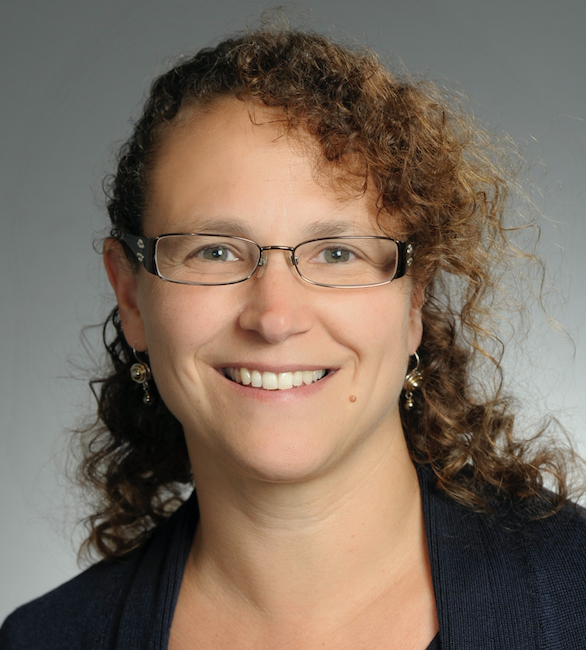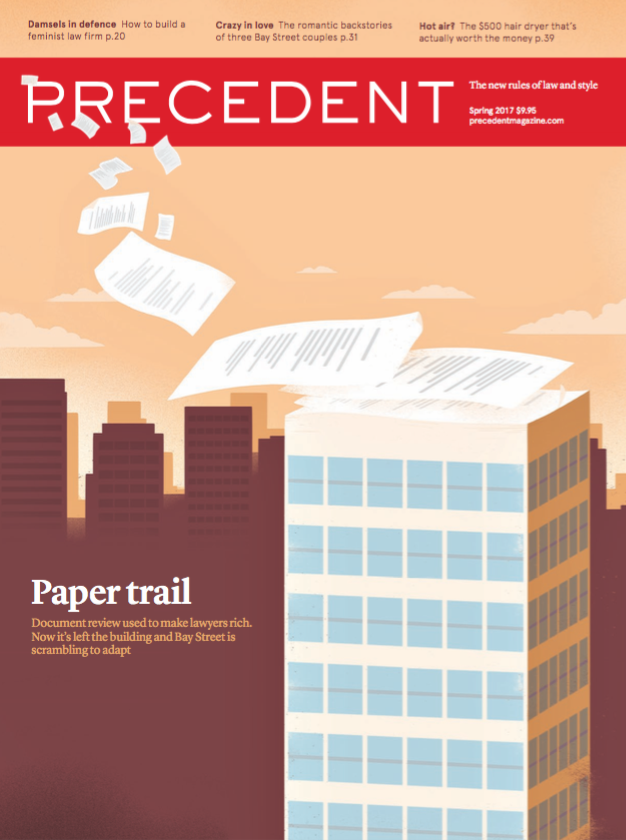ANNE GLOVER COULD SEE THE EVIDENCE EVERYWHERE: HER ENTIRE JOB WAS ABOUT TO CHANGE. It was the beginning of 2013, and Glover had just made partner in the litigation group at Blake, Cassels & Graydon LLP. Her task was to take control of the firm’s document-review strategy. Such work can be so boring that some lawyers find it painful. But it was Glover’s life. She had spent her career as an associate becoming an expert in the field.
It’s a good thing some lawyers care about it. Yes, it’s tedious for lawyers at the outset of a lawsuit to sift through all of the documents — emails, text messages, tax receipts — that belong to their client and the other party. But somewhere in that swamp, buried in the mud, is the one email in which an executive cops to stealing from investors. That’s what lawyers need: the smoking gun that wins the case.
Hunting for smoking guns is more than good strategy. It can also be lucrative. Historically, large law firms would have junior associates toil away on document review, both to pay their dues and to rack up billable hours. This would bring in enough money to pay associate salaries and pad the profits of the partnership, a perfect example of a cash cow.
“All of a sudden,” recalls Glover, “there was a dramatic shift.” The hinge moment on which this story turns is the financial crisis of 2008. Facing unprecedented market turmoil, big businesses looked to trim their budgets. “By 2009, clients started to tell us they wanted to spend less on document review,” says Glover. “They said that we must use an outsourcer.”

Anne Glover, partner at Blake, Cassels & Graydon
Those outsourcers take many forms — from massive companies in India to small outfits in the American Midwest — but they have one thing in common: they hire contract lawyers to pore over documents for a lot less money than Bay Street firms pay their associates. “We started to watch that work leave the firm.”
In a flash, junior associates went from profit centres to liabilities. Big firms cut the number of student jobs. Back in 2008, the largest 16 firms in Toronto hired 323 second-year summer students. In 2010, they hired 289. (For the upcoming summer, they’ve hired 257, a 20 percent drop in 10 years.) So it’s clear: the good times are over.
In the beginning, Glover accepted outsourcing as the new normal. But in mid-2013, her entrepreneurial antenna shot up: she had a plan to reclaim some document-review work for Blakes. Today, she’s pulling it off. Glover has built a document-review team within Blakes and persuaded clients to use it instead of role an outsourcer.
To get the whole story, I visit Glover at the Blakes office in Commerce Court West. On my arrival, I head to the litigation floor and Glover shows me into a small lounge area with two couches and a coffee machine. Glover, a slight woman, is relaxed and easy to chat with. As we take our seats, she introduces me to Carla Swansburg, the firm’s director of practice innovation. To put it another way, her job is to keep the firm competitive. So when Glover hatched her plan, she turned to Swansburg to help her pull it off. “Anne has been just brilliant,” says Swansburg, who smiles constantly and seems to have genuine fun when talking about the future of law. Swansburg has had a nomadic legal career: she worked as an associate at Osler, Hoskin & Harcourt LLP for eight years, at Ogilvy Renault LLP for another four and then spent six years in-house at RBC before landing at Blakes in 2011. The two women make for an impressive duo.
I start by asking Glover a simple question: what does she have against outsourcing? “I know that if we do the work, we’ll do a better job,” says Glover. Blakes gets total control of the file, she explains, and the reviewers have moment-to-moment access to the partners leading each file.
But, I point out, that sounds strangely similar to the old way of doing things, with armies of associates doing the work. Clients won’t pay for that anymore. “You’re absolutely right,” Swansburg chimes in. “We had to step back and build an entirely new business model.”
SO HOW DID OTHER LARGE FIRMS REACT TO THE RISE OF OUTSOURCING? Most went along with it, and now outsource the lion’s share of their document review. Take Gowling WLG. When I call Rick Kathuria, the firm’s director of project management and legal logistics, he sums up his approach this way: “We don’t really have a preference between insourcing and outsourcing.” So to break the tie, he often goes with what saves the client money. Most of the time, that’s outsourcing.
“But on small files,” he adds, “it can be cheaper to do the work in- house.” That’s because it costs time and money to brief an outsourcer on a new project. That up-front cost isn’t worth it for the smallest files. When Gowlings takes on a review project, it often sends the work to lawyers at one of its lower-cost offices in Hamilton, Waterloo or Ottawa.
A block away, at McCarthy Tétrault LLP, the post-recession plan has been to outsource as much as possible. Before it landed on that strategy, though, the firm flirted with the idea of building its own doc-review team.
“We looked at that, but didn’t think we could pull it off,” says Matthew Peters, the national innovation leader at McCarthys. “The main reason is scale: outsourcers have hundreds of clients around the world, and we can’t compete with that.” Outsourcers would always be cheaper.
Then, at the end of 2016, McCarthys made a surprising move for a law firm. It acquired Wortzmans, a document-review firm in Toronto. This is unusual for a couple reasons. One, it makes McCarthys an outsourcer itself. And two, the firm is acting like the big accounting firms, who have also charged into the document-review game through acquisitions. The most high-profile example is Deloitte. In early 2015, the global giant bought ATD Legal Services, a commanding force in the Toronto outsourcing game. (It was the brainchild of Shelby Austin, a former partner at Davies Ward Phillips & Vineberg LLP, who founded the company in 2010.)
At McCarthys, the plan going forward is to send plenty of work to Wortzmans, which it now owns. Peters says the goal is also to have Wortzmans continue to conduct document review for other law firms across the country. “We want to be one of the dominant providers of document review in Canada,” he says. “And we think we can do that.”
BUT AT BLAKES, FOUR YEARS AGO, GLOVER WAS PLOTTING A DIFFERENT MODEL. She hatched a plan to keep as much document review in the firm as possible.
The first problem she had to solve was labour: clients would not pay for associates to review documents. So Glover’s solution was to hire staff lawyers and make document review their sole job. They would earn less than associates and have no shot at making partner, but they would be full-time employees. After advertising for one position, the applications poured in. “The market is glutted with excellent new lawyers who can’t get jobs,” explains Swansburg.

Carla Swansburg, director of practice innovation at Blake, Cassels & Graydon LLP
Glover hired one staff lawyer right out of the gate, and quickly added two more. In that first year, Glover persuaded a few clients to use the Blakes team for small projects. But she wanted to scale up and pitch the service to clients embroiled in large lawsuits. To take her plan to the next level, she had to go to the firm’s executive committee.
“I went to them,” says Glover, “and said, ‘We tried this out, and it’s working. The people we have are busy. They’re not sitting around twiddling their thumbs. And we’re profitable.’”
The top brass had one concern. Glover was on track to create a bottom tier of lawyers, consigning them to do work most lawyers loathe. Could the culture of the firm handle that?
“We’d already thought about that,” says Glover. “For one thing, we planned to recruit for these roles directly. We generally don’t take associates who don’t make the cut and move them to document review.” And Glover was certain that there would be no shame in working as a staff lawyer. “We were going to train these lawyers to be experts in document review. This work is important, and the firm would respect them for that.”
Glover got the green light to hire more people and set up an open-concept workspace. And Blakes even gave her team a name — inSource, with its own logo and a page on the firm’s website. Things were getting serious. But before Glover could land any major review projects, she had to do one more thing: make a big investment in the latest legal technology.
THE WORD “E-DISCOVERY” IS THE EPITOME OF JARGON — IT SOUNDS COMPLICATED, BUT IN FACT REFERS TO SOMETHING SIMPLE. The term was born about a decade ago, when large businesses had shifted from keeping paper records to storing everything on computers. When caught up in a lawsuit, they no longer shipped boxes of paper to their lawyers. They dropped off hard drives. So lawyers started to review documents on computer screens. That, at its root, is e-discovery.
All of a sudden, there was a huge demand for software that would help lawyers annotate and sort through digital files. Competition among tech startups was fierce to build software that could dominate this new market. And within a few years, Relativity, coded and sold out of Chicago, became the industry standard for tech-assisted document review.
“When we hit the scene in 2006, we were really simple,” Shawn Gaines, the director of marketing for Relativity, tells me over the phone from Chicago. “We helped lawyers host and mark up massive numbers of documents. Nothing too fancy.”
But the coders at the company — now 300-strong — didn’t sit still. In 2009, they added a concept-search function. Then, in 2011, they dropped a game-changer, equipping their search tools with machine learning.
This simply means that the software could use algorithms to learn from its mistakes. Gaines gives me an example. “Let’s say a lawyer comes across a document that looks like a weekly newsletter,” he says. “It’s obviously not relevant to the case, and there are probably more like it out there. So the lawyer can ask the system, ‘Can you find more documents like this one?’” The software combs through all of the documents and spits out a handful it thinks are similar. Next, the lawyer marks which of those documents are newsletters and which ones are not.
That’s when the machine learning kicks into action: it uses that feedback to refine its definition of a newsletter. If it locates 10,000 newsletters, the lawyer can tag them all as irrelevant without having to read them one by one. This tool has the power to slash the amount of time it takes to complete a document-review project.
Glover knew she had to license the technology, but that didn’t put her ahead of the curve. In fact, when I ask Glover about the software, she cuts me off. “Look, we use Relativity, but so do our competitors,” she says. “So don’t misrepresent this in your story as what’s innovative about what we’re doing. It’s not.”
That’s true. Many outsourcers use the program. So do many large firms — Gowlings, for instance — who use it for smaller projects they take on. Glover needed it not to blaze her own trail, but to be baseline competitive.
As she was bringing Relativity into the firm, in late 2014, Glover went on a hiring spree. In the past two years, inSource has grown to 19 lawyers. When Glover conducts interviews, she is candid. “I say, ‘Look, I know you don’t want to do this for the rest of your life. That being said, you’re really smart, so let’s see if there’s a way we can make this work for a little while.’” She doesn’t expect staff lawyers to stay forever and encourages them to go for job interviews at other firms. And last year, she even paid for her team to attend sessions with a career counsellor.
So far, inSource has been a modest success: the team has won some large review projects.
“We’re more expensive than an outsourcer,” says Glover, “but we do better work.” Some clients, she adds, will pay a bit more so that the review team has close contact with the partners leading the file. “This is a big advantage,” says Glover. “With outsourcers, firms have to set up a call each time they have a question.”
Perhaps her biggest achievement, though, is clawing back some of the document-review revenue the firm had hemorrhaged to outsourcers. I suggest to Glover that the firm’s executive must be thrilled. “Oh, absolutely,” she says. “If we weren’t making any money, they would have asked, ‘What are you doing this for?’”
 DOCUMENT REVIEW WAS JUST THE BEGINNING. In the past few years, corporate clients have shot dead another law-firm cash cow: the due diligence phase of a merger or acquisition.
DOCUMENT REVIEW WAS JUST THE BEGINNING. In the past few years, corporate clients have shot dead another law-firm cash cow: the due diligence phase of a merger or acquisition.
When one company decides to buy another, it won’t sign on the dotted line until its legal team has reviewed the other company’s slate of contracts. After all, it will have to honour each one once it takes over, so it’s a good idea to make sure they don’t contain any red flags.
The first step is labour intensive. The legal team goes through the contracts and pulls out the types of clauses most likely to cause trouble. To take a common example, they identify every “change of control” clause. These clauses set out what happens in the event of an acquisition. On occasion, they force the new owner to make a lump-sum payment to keep the contract active. Needless to say, this would affect the final price of the deal.
But the goal, at first, is not to analyze these clauses. It’s just to find them. Historically, high-billing associates did this work — yet another thing clients will no longer tolerate. Though the work is time-consuming, it doesn’t take any deep legal thought. Which is why outsourcing this work has become common.
And so, unsurprisingly, Glover has expanded the scope of inSource to include due diligence. “We spend 75 percent of our time on document review,” she says, “and 25 percent on due diligence and other legal tasks.”
To stay competitive with outsourcers, she has once again had to license new technology. But Glover didn’t turn to a company in Chicago or New York.
In this field, the leading software, called Kira, is Toronto-made. (One of its competitors, Diligen Software, is also headquartered in Toronto, at the Ryerson Legal Innovation Zone.) On a crisp winter morning, I stop by the Kira Systems office, which sits in a brick-and-beam building a few blocks west of the financial core. The co-founder, Noah Waisberg, meets me in a boardroom.

Noah Weisberg, CEO of Kira Systems
He’s wearing dark blue jeans and a black sweater. In a deep, charming voice, he delivers a bullet-point version of his biography: born in Toronto, holds a masters in political science from Brown University, earned a law degree at NYU. After law school, he got a job at Weil, Gotshal & Manges LLP, a white-shoe law firm in New York. But in 2010, after nearly four years at the firm, he quit. “I saw that people were wasting so much time on certain legal work,” recalls Waisberg. “I knew there was a business opportunity, but I didn’t quite know what. I left my job and just sat and thought.”
Soon enough, he had his epiphany. Associates should not spend hours extracting clauses from contracts. Computers should.
Not just to save time. Waisberg had another reason to keep associates away from the first phase of due diligence. “They consistently screw it up,” he says. “Let’s say an associate is looking for change-of-control clauses. They face several obstacles. One, they’re bored. Two, they’re working at 2 a.m. and they’re in a fight with their boyfriend or girlfriend. So they’re struggling to pay attention.” But it’s crucial that they do, because most contracts are poorly written. “It’s not like every change of control is labelled as one. Many are not.”
So what was Waisberg’s big idea? To build software that could locate clauses in contracts and sort them into manageable reports.
It took two-and-a-half years and most of his savings to finish the program. Much like Relativity, Kira relies on machine learning. If a lawyer shows it a large sample of a certain type of clause, it can go out and find more of them within a set of contracts. Waisberg spent hours teaching the software how to find a range of common clauses, so he could sell it pre-trained.
He’s landed some big clients. Waisberg has sold the software to Clifford Chance (a Magic Circle firm) and Deloitte (a major outsourcer). Waisberg now has 40 employees — a mix of software engineers, salespeople and lawyers that train the software to role find a wider set of clauses.
Another customer is Torys LLP, which licensed Kira in 2015. Though the firm outsources most of its document review, the corporate group has ginned up a strategy to keep due diligence in-house at a low cost. That strategy starts with the firm’s decision, in 2014, to open a low-overhead office in Halifax. That office has since become the home base for five staff lawyers that specialize in contract review. These lawyers, just like those on Glover’s inSource team at Blakes, will never make partner.
“You could call this the near-shoring model,” says Chris Fowles, the Torys partner who runs the Halifax office. Another way the firm keeps costs down is to use Kira. “Having the software take a first pass through the documents is a big thing,” says Fowles. “It won’t tell us when something in a contract is a problem, but it gives us a quick overview of every- thing we want to look at.”
Blakes, for its part, is a bit behind Torys. The firm expects to start using Kira soon, but is still hammering out the details of a pilot project. Blakes is excited to get going. “It’s such an amazing tool,” says Swansburg. “It’s hard to say exactly how much time it will save, but it should drastically improve efficiency.”
WHAT DOES ALL OF THIS MEAN FOR THE BIG LAW JOB MARKET? On one hand, there has been growth in alternative legal careers. Glover’s 19-lawyer insourcing team is a testament to that. There are also more contract jobs — which, of course, pay less than full-time work and lack both benefit packages and job security — than ever. The largest legal outsourcers in the city, from Deloitte to the now-McCarthys-owned Wortzmans, hire lawyers on a project-to-project basis.
But if technology continues to reduce the time it takes to do rote legal work, it stands to reason that big firms will continue to hire fewer juniors. “At some point, document review and due diligence won’t be about dozens of humans looking at millions of documents,” says Ron Dolin, a research fellow at Harvard Law School and legal-innovation expert. “It’ll be about getting a handful of people to run the software.”
When I speak with Ben Alarie, a law professor at the University of Toronto, he offers a bleak analogy. “Document and contract reviewers are like Uber drivers,” he says. “With Uber investing in self-driving cars, those drivers are looking at a short career. The same thing is probably true of lawyers who review documents. It will only get easier to automate large parts of their work, so it’s hard to see how those jobs are sustainable.”
Over at Blakes, Glover concedes that, going forward, there will be fewer partner-track associates at big firms. But she’s an optimist at heart. She thinks that as law firms become more efficient, they can generate more business. And she predicts that the ongoing upheaval in Big Law will spawn new types of legal jobs that no one can foresee. “Look, I’m a partner at a big downtown law firm and I’m doing something I never would have expected,” she says. “It’s true that the old business model doesn’t work. So we have to change. And change scares people. But it also creates opportunities. To me, that’s really exciting.”
 This story is from our Spring 2017 issue.
This story is from our Spring 2017 issue.
Illustrations by Sébastien Thibault


